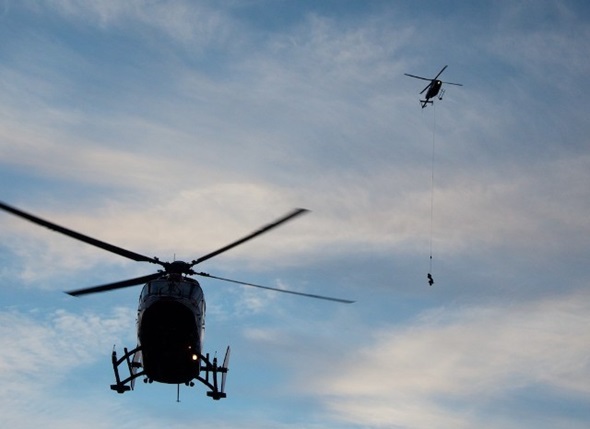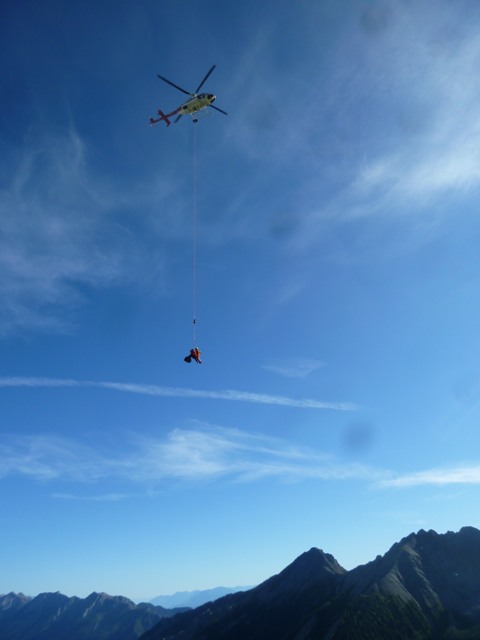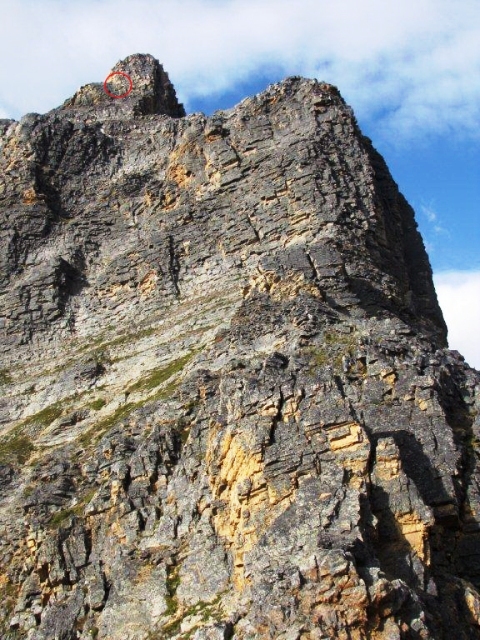Accident Reports - September 2011
Mountain safety
Injured climber, Mt Lefroy, Banff National Park, September 17th, 2011
Stranded Climbers, NW Ridge of Mt Sir Donald, Glacier National Park, September 11 2011
Injured hiker, Sentinel Pass, Banff National Park, September 5th, 2011
Injured scramblers, Fairview lookout, Banff National Park, September 5, 2011
Injured hiker, Kindersley Pass trail, Kootenay National Park, September 4th, 2011
Injured climber, Mount Peveril, Jasper National Park, September 1st, 2011
Injured climber, Mt Lefroy, Banff National Park, September 17th, 2011
Two climbers got to the top of Lefroy at approximately 1 pm. They unroped and were checking out descent options or perhaps starting to descend when one of the climber's crampons slipped on some rock/ice. He tried to self arrest, but despite having the leash on, his ice axe was ripped out of his grip. He tumbled 400 m down the face to where the slope angle became less severe. His partner took 2 hours to down climb to him. Another party of 5 from the hut came to his aid in trying to get him back to the hut.

The West Face of Lefroy. The climber slid from the summit to the red stop sign, and then was transported back to the hut. / © Parks Canada
At 4 pm, the reporting person called Parks Canada using his cell phone and gave excellent information on the mechanism of injury, patient and weather conditions. He said they were within 100 m of the hut the patient was stable and was complaining of ankle injuries. He was conscious and alert and not complaining of any neck or back pain. By the time the rescue team arrived, the climbers had gotten the patient to the Abbots Pass hut and wrapped him in blankets. They shovelled the snow off the heli-pad and ensured the landing flag was visible which greatly assisted the pilot in landing at the col, which is a notoriously difficult location to land at. Due to the difficult flying and the potential for cloud to roll in from the Lake Louise side, the pilot decided to not shut down and asked the rescue team to be as quick as possible. The rescue team went into the hut and carried the patient back to the helicopter. The patient and his climbing partner were flown to the waiting ambulance at the Lake Louise Parks office.
Analysis
Miraculously, the patient wound up only having a possible sprained ankle! A contributing factor to the slip was the fresh blanket of snow that may have hid the underlying rock/ice. The partner and other climbers in the area did a great job in getting the patient back to the hut, providing great information to the rescue team and preparing the landing pad at the hut for the helicopter.
Stranded Climbers, NW Ridge of Mt Sir Donald, Glacier National Park, September 11 2011
Two climbers set out to climb the NW ridge of Sir Donald. They left the Uto-Sir Donald Col at 8am and reached the summit at 2pm. Due to snow on the “northwest by-pass” section of the descent, the two chose to descend from the summit via the NW ridge. The descent was slow; the group was not comfortable down-climbing many sections, forcing them to rappel the majority of the ridge. By dusk, the group had reached the bolted section of the descent, which consists of a series of 25m rappels with bolted stations. Using their 60m rope they rappelled from the 4th station, but were unable to see the next bolted station and rappelled the full 30m to the bottom of their rope. It was now 8pm, fully dark and the group had lost the rappel route. They chose to stop and spent the night on a small ledge. At 5am the group, nervous about having lost the established route and out of food and water, called 911 with their satellite phone and notified the dispatcher that they were uninjured but required a rescue.
The climbers' 9-1-1 call was relayed to Parks Canada’s Dispatch, which notified Glacier National Park’s on-call Visitor Safety (VS) Specialist. Unable to contact the group on their sat phone to get more information, two VS Specialists responded in a helicopter. The Specialists were easily able to find the group, who were approximately 5m from the 5th bolted station, and set up for a helicopter sling rescue. One Specialist was slung up onto the ledge with the climbers, and each climber was slung off the mountain separately.  |
|
The scene. Green circles indicate approximate station locations. Red circle indicates where the stranded climbers were picked up./ © Parks Canada
Analysis
There are numerous lessons to be learnt here:
1) The NW ridge of Mt Sir Donald is a route that is often underestimated. The climbing is not technically difficult but the route takes time and it is not uncommon for parties to spend a night along the route. Start early and give yourself as much daylight as possible to complete the climb.
2) The group had the Sir Donald rappel route description and were aware that the bolted stations were 25m apart. However they were using a 60m rope and rappelled past the station, causing them to lose the rappel route. Had they stopped 5m above the end of their rope and searched, they would have found the station.
3) Having spent a long night on a ledge pondering their situation, the group chose to call for rescue before the sun came up. While visitors are encouraged to request assistance before they dig themselves in too deep, had the party waited until the sun came up their situation would likely have felt much different and they may have been able to get themselves back on route.
Injured hiker, Sentinel Pass, Banff National Park, September 5th, 2011
On a beautiful late summer day, a group hiked up the Larch Valley to Sentinel Pass with the intent of hiking out Paradise Valley. Once they reached the pass, they descended onto the colder north facing slope and encountered some snow patches along the trail. The group decided to slide down one of the snowslopes, instead of walking around it. The snow was still quite firm, and one of the hikers lost control and slid into the rocks at the bottom, injuring his ankle, and also sustaining cuts to his forehead. The group did not have an emergency communication device, so they sent a few group members to quickly get to the trailhead and call Banff dispatch for a helicopter evacuation.
VS Specialists were dispatched from both Banff and Lake Louise, and arrived on scene by helicopter. After a quick reconnaissance of the area, the VS team decided to use the heli sling system to access the site, splint and package the patient, and then sling the patient out to staging and then on to Emergency Medical Services waiting in Lake Louise. 
The accident scene. The arrow shows the snow slope that the patient slid down. The circle shows the bad runout, where he came to rest after the slide. / © Parks Canada
Analysis
Even small snow slopes can be dangerous places. If a person loses control, they can accelerate very quickly, and, in the summer, often into a poor runout. If one decides to slide down a snow slope, it is important to check the conditions of the snow before committing to the slope. Snow conditions can vary dramatically depending on the time of day, the air temperatures, and which direction the slope faces.
In this accident, the group traversed onto a cold, north facing snow slope where the snow was still quite hard and didn’t realize the seriousness of the terrain they were in. A slip, combined with the bad runout resulted in vacation ending injuries.
Finally, the group had no emergency communication devices, so the rescue response was slowed by the extra time it took for the accident to be reported to Parks Canada. On a positive note, the group had plenty of warm clothes, along with adequate first aid supplies and training in order to treat the patient and keep him warm while they waited for help.
Injured scramblers, Fairview lookout, Banff National Park, September 5, 2011
A party of five was scrambling around above Fairview Lookout. They got lost in the dark for about five hours and then one of them fell about fifty metres downslope through broken terrain.
Since the subject was in critical condition, the Visitor Safety Specialists responded at night by climbing into the site with one paramedic in easy scrambling terrain. They stabilized the victim and slung the patient out at first light to a STARS helicopter waiting at the Chateau Lake Louise staging area. The other four people were assisted down to the lookout and down the trail before daylight. 
A Visitor Safety Specialist is slung to the staging area as the STARS helicopter takes off with the patient. / © Parks Canada
Analysis
This group wandered off trail at the Fairview lookout and got themselves into serious trouble. There are many rough, non-maintained trails in the Mountain Parks which often lead into steep, serious terrain. Visitors should be cautious when venturing off maintained trails, especially at night. In addition, it is recommended for visitors to research their trip in order to be prepared for the terrain that lies ahead and how to find their way back if they get turned around.
Injured hiker, Kindersley Pass trail, Kootenay National Park, September 4th, 2011
A party of two and a dog was hiking the Kindersley Pass trail when they heard a grunting noise coming from the bushes. They had walked into a Grizzly bear who was feeding in the dense vegetation, and when they realized what it was, they ran off the trail to avoid the bear. One of the hikers tripped and injured her ankle as she was running from the bear. Luckily, the hikers didn’t see any other sign of the bear, and happened to run into another group of hikers who were able to send someone to call for help and assist in helping the injured hiker down the trail.
Parks Canada Visitor Safety Specialists received the call and were dispatched from Banff, along with a Parks Canada Wildlife Specialist to secure the area from a wildlife perspective. The team located the injured hiker, landed and then prepared for a helicopter sling rescue. The injured hiker was slung out and transported to Banff hospital by helicopter. 
A Visitor Safety Specialist slings the injured hiker to the staging area. / © Parks Canada
Analysis
It was an unfortunate circumstance to sustain an injury while trying to run from a Grizzly, and it turns out that the hiker’s ankle was broken. However, the backcountry is full of wildlife and there are a few precautions that should be taken when travelling in bear country:
- Make lots of noise! Yodel, yell, etc... anything to let the bear know you’re coming so that you don’t surprise it.
- Always carry bear spray in an accessible location. (This party was).
Some areas are more popular with bears than others. The Kindersley Pass trail is excellent bear habitat and has often been closed in the past because of Grizzlies hanging around. Caution is advised.
Injured climber, Mount Peveril, Jasper National Park, September 1st, 2011
On September 1st 2011, a party of two were climbing on the NE Ridge of Mount Peveril. This is an alpine style, predominately quartzite rock climb in the Portal Creek drainage near Marmot Basin ski hill in Jasper National Park. At approximately 2,700m on the 2nd section of 5th class climbing in a location sometime referred to as the 2nd ridge, the leader took a 30 foot lead fall onto a sloping ledge. The fall occurred when he pulled on a hold which turned out to be part of a large loose block. As the block pulled out, more rock failed and a lot of rock came down. As the opportunities for effective rock protection had been limited, he had only managed to get one large nut placement in. At the time of the fall, this was about 10ft below him and approximately 15ft above the level of his belayer, who was off to the side, and out of harm’s way. The leader impacted the sloping terrain having fallen 25ft and then proceeded to tumble down the 30 degree rock and boulder strewn slope past his belayer until the rope stopped him from going over the cliff below. The accident occurred at approximately 12:00. The climber was rendered unconscious by his fall for approximately 5 minutes before regaining a reduced level of consciousness. His partner was able to access a satellite phone (Iridium) they were packing, and called for assistance. 
NE Ridge of Peveril Peak. The red circle shows the site of the accident./ © Parks Canada
The Jasper National Park Dispatch Centre received the call at approximately 12:15. Due to the many high peaks in the area, only limited information was received by the Rescue Leader before the call was dropped. Fortunately, a Bell 407 helicopter along with an experienced rescue pilot were on call in the Park. A staging area crew was sent to the Portal Creek trailhead and at 12:50 a team of two Visitor Safety (VS) Specialists departed the Parks Compound in the helicopter to locate the climbing party. The weather was unsettled, with heavy dark clouds and a cold air mass lingering over the area. The winds were gusting to moderate at the elevation of the accident. The party was quickly located and a reconnaissance completed, before the helicopter returned to the staging area four kilometres downstream of the mountain. At 13:15, a VS Specialist was heli-slung into the accident site with medical supplies and climbing equipment. The injured climber did not appear to have any life threatening injuries and was regaining a more lucid level of consciousness. The helicopter returned with a second VS Specialist on the long line. The patient was attached to the line, and was slung back to the staging area where an ambulance crew was waiting to receive them.
Analysis
The patient was released from hospital the following day sore and bruised. As an experienced climber, he provided the following analysis of the events:
Things that worked well were:
- Both climbers knowing how to use the sat phone.
- Having a sheltered belay.
- Taking a belay on the easy pitch.
- Putting in at least one good piece of gear on the route before continuing.
- Having a thicker rope to catch a fall with.
- Having some extra clothes to stay warm with.
Things to do better were:
- Putting in more gear if possible.
- Maybe taking the easier line to the left.
- Testing the holds more thoroughly.
Related links
- Date modified :